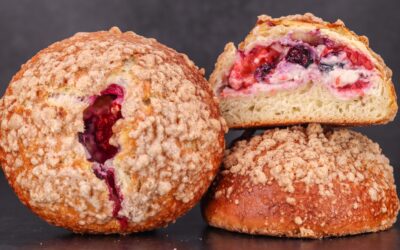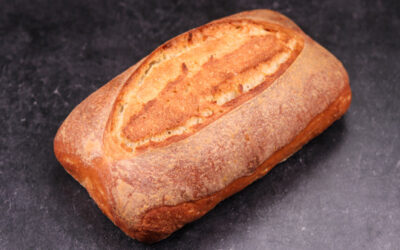You know I love cold fermentation. Usually, I stick with cold bulk fermentation and then finish the final proof at room temperature the next day. Cold proofing flips the process upside down. The bulk fermentation is done at room temperature and the final proof is finished in the fridge.
Cold proofing is the perfect method for breakfast bakes because all you need to do the next day is pre-heat the oven and bake the bread. You can find a few recipes using this method in the Cold Fermented Dough playlist.
Little ciabatta rolls are ideal for breakfast. They are hearty, taste great, and can hold a lot of topping/fillings. You can leave them as they are, or you can toast them.
What makes this recipe even better is that there is no kneading. The dough is simply folded a few times during bulk fermentation instead.
This recipe makes 4 rolls. To make more simply multiply all the ingredients. If you want larger ciabattas, then just divide the dough into fewer pieces.
The temperature of my fridge is around 5C – 6C (41F – 43F). If your fridge is cooler or warmer, then you may need to adjust the bulk fermentation time slightly.
Watch the video down below for detailed instructions.
Ingredients
For the dough –
230g (8.1oz) white bread flour
20g (0.7oz) whole wheat flour
5g (0.17oz) salt
2.5g (0.09oz) instant dry yeast or 3g (0.1oz) active dry yeast or 7.5g (0.26oz) fresh yeast
190g (6.7oz) water*
*To learn more about dough temperature control click here.
The flour I use has a protein content of 13%. If your flour is weaker, then you may need to lower the hydration.
If you are using active dry yeast, then you may need to let it sit in the water for 10 minutes before adding the other ingredients or else it could take a lot longer to raise the dough.
Method
- In a large bowl combine the water, yeast, salt, and whole wheat flour. Mix well to dissolve the salt completely, hydrate the yeast, and to disperse the whole wheat flour in the water.
- Add the white bread flour and mix to a dough. *Desired dough temperature 24C -25C (75F – 77F).
- Cover and ferment for 15 minutes.
- Fold #1
- Ferment for 15 minutes.
- Fold #2
- Ferment for 15 minutes.
- Fold #3
- Ferment for 45 minutes.
- Dust the dough generously with flour and invert it on a floured surface. Trim the edges and cut it into individual rolls.
- Place on a floured couche. Separate the rolls with the folds of the couche. Place the trimmed off pieces on each roll.
- Cover and leave to cold proof for 12 hours.
- Pre-heat the oven to 250C (482F) fan off.
- Invert the rolls on a piece of non-stick paper. Slide them in the oven and steam the chamber. Turn the temperature down to 230C (446F).
- Bake for 17 minutes.
Leave to cool down slightly and enjoy!
Keep in mind that the conditions in each kitchen are different, so fermentation times may vary for you. It is up to the baker to control the bread and react accordingly.
Your oven may be different too, so your baking time may vary.
Watch the video here



